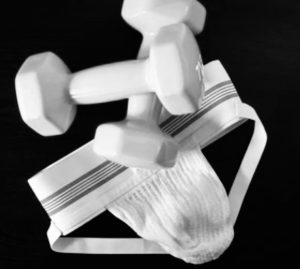Boxers or briefs?
In my men’s health practice, a somewhat common question is the choice of underwear for men. Most men are wearing boxer briefs, however in a roundabout way they finally ask about going commando? Is foregoing underwear – a viable option?
The term “going commando” is believed to have military roots. It suggests a no-nonsense approach, possibly originating from commandos’ need for practical clothing options in challenging environments. For instance, in the hot, humid climates of Vietnam and the Pacific Theater during World War II, soldiers often skipped underwear to avoid chafing and irritation. This practice was not exclusive to commandos; regular troops, too, found it pragmatic, especially in conditions where cleanliness and comfort were hard to maintain.
Interestingly, in my own military experience during Operation Iraqi Freedom in 2006, I noticed a unique compromise: the adoption of the jockstrap. While some troops went full commando for coolness and reduced chafing, others found the jockstrap an ideal middle ground. It provided necessary support without the discomfort of tight, synthetic undergarments – a crucial factor in the blistering heat.
The decline of the jockstrap’s popularity can be partly attributed to changing societal norms and the rise of homophobia. Historically, the jockstrap was a symbol of masculinity and athletic prowess. However, as societal perceptions of masculinity shifted and unwarranted homophobic sentiments grew, many men shunned the jockstrap, associating it with vulnerability rather than strength. This shift coincided with the rise of alternative undergarments like compression shorts, which offered a different form of support without the cultural baggage.
The phrase “going commando” itself has an interesting trajectory. While its military origins are well-documented, its entry into civilian parlance is murkier. The term gained widespread recognition in the 1990s through popular media, such as the television show “Friends.” However, its use dates back at least to the 1970s, possibly as a reference to the conditions faced by soldiers in Vietnam.
Regarding the adoption of going commando in the military, there’s practical reasoning behind it. In environments where heat and humidity pose a risk, going without underwear can enhance ventilation and minimize the risk of fungal infections like crotch rot. Military advisories, while not outright banning underwear, do suggest wearing minimal clothing to prevent heat injury. Pilots and armored vehicle personnel are specifically advised against synthetic undergarments due to the risk of heat transmission in flame-retardant suits.
Returning to the present, the choice between traditional underwear, going commando, or opting for a jockstrap is more than just a matter of personal comfort; it reflects broader cultural trends and historical practices. While commandos and soldiers have embraced these options out of necessity, today’s men have the freedom to choose based on comfort, lifestyle, and personal beliefs about masculinity.
For those who value the benefits of going commando but seek support, the jockstrap can be a formidable choice. Its decline in popularity, shaped by shifts in cultural attitudes towards masculinity and misconceptions, doesn’t diminish its practicality. As a middle ground between the freedom of going commando and the support of traditional underwear, it offers a unique solution – one that challenges contemporary notions of masculinity and harkens back to a time when practicality was the prime consideration in a man’s wardrobe.
Because many men under 45 will have no idea what a jockstrap is I have included a picture:

Man up

How can a man not know what a jockstrap is??
They’ve faded so far away from culture when compression shorts seemed to take over the athletic wear, that perhaps younger generations will be oblivious to them. Younger generations did not experience YMCAs back in the day, or school showers which were more communal in nature, and locker rooms that featured the ability to see classmates, teammates, whathaveyou, almost all wearing jockstraps.
Go command, in the ‘Go’ command, might be the source of the term. In translation, when troops were given the ‘Go’ command, they immediately got up to go. Uniforms had to be worn, but rather than pause for underwear, it was left off. Re: jockstraps, which were prevalent for decades, ‘inspected’ by gym teachers, some said, I wonder if the lack of a back fabric was the problem, when guys undress beneath towels at the school gym, IF they shower, do so with underwear on. Bare butts, horseplay, perhaps too much. In my writing, I have traced a lot to the hyper masculine, paternal, post world war periods which ordered male, not female, swimmers into pools naked, ruled that wrestlers would weigh-in wearing ‘no more than a suitable undergarment.’ Today, singlets are worn, briefs required, forgetting about the claim that every ounce mattered.